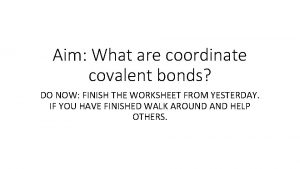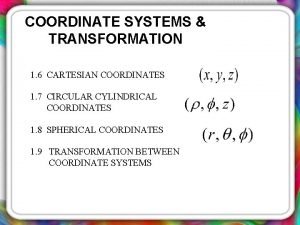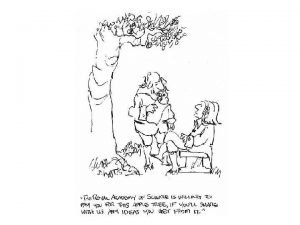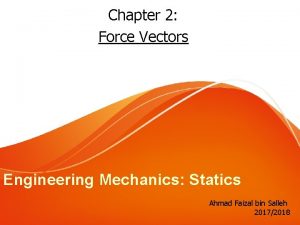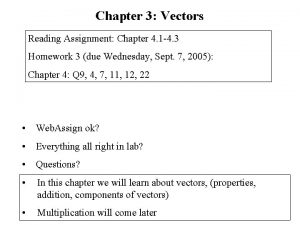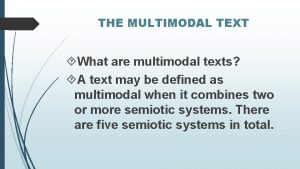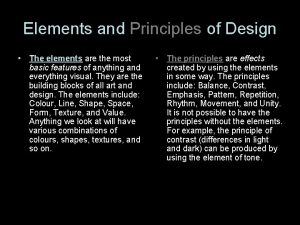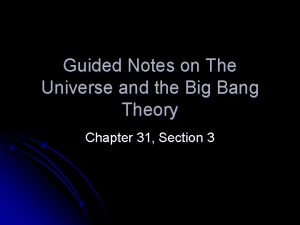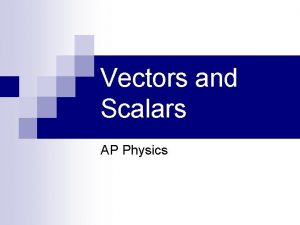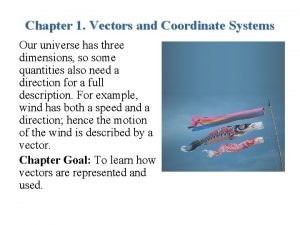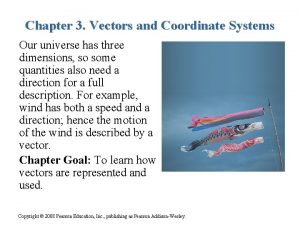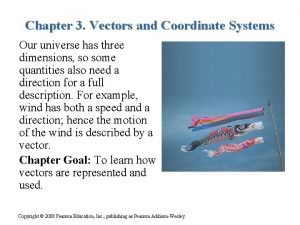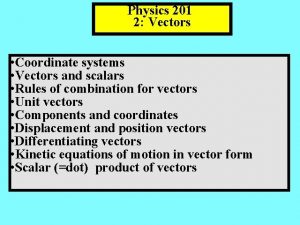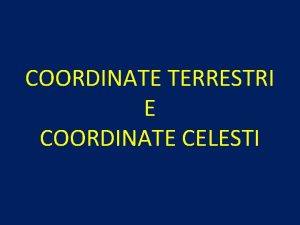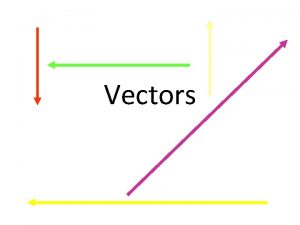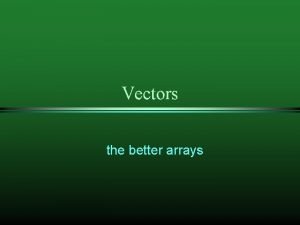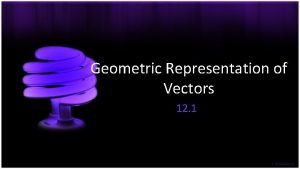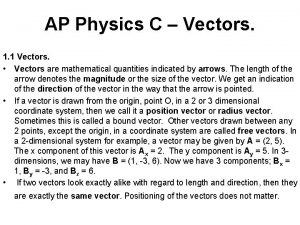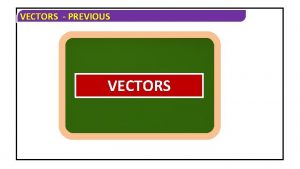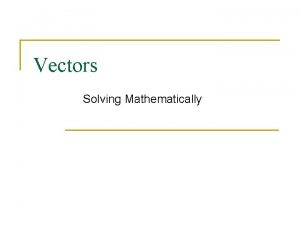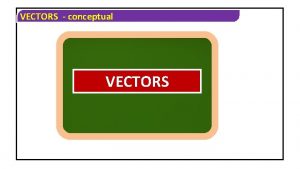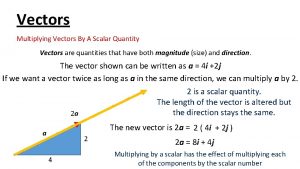Chapter 3 Vectors and Coordinate Systems Our universe





































- Slides: 37

Chapter 3. Vectors and Coordinate Systems Our universe has three dimensions, so some quantities also need a direction for a full description. For example, wind has both a speed and a direction; hence the motion of the wind is described by a vector. Chapter Goal: To learn how vectors are represented and used.

• A scalar quantity is one that can be completely described by its magnitude (size). • Examples include temperature, energy, and speed • Some scalars can be described with negative numbers (1 st two examples, above, but not the third). In that case the negative sign means the quantity is less than a positive quantity. +30°C -30° C

• A vector quantity has both magnitude and direction. • Examples include velocity, force, and displacement • Vectors are never negative. A vector has a magnitude, which is an absolute value and a direction, which is usually given as an angle. • Vector components may be described with negative signs. In that case the negative sign never means less than. It means “left” or “down” on a graph, and west or south on a map. The y component of velocity is – 40 m/s. The y component of velocity is + 40 m/s. Both cars are going at the exact same speed!

Arrows are used to represent vectors. The direction of the arrow relative to some reference point (north or + x axis) gives the direction of the vector. The length of a vector arrow is proportional to the magnitude of the vector. 4 m 8 m

This is an example of a displacement vector with magnitude of 2 km and direction 30° north of east

Graphical Addition: Put the tail of one vector after the head of the other. The resultant vector is an arrow that starts where the first vector starts and ends where the second vector ends.

This is easy if the two vectors are co-linear, especially if they point in the same direction. These vectors add just like scalars. 3 m 5 m 8 m

If the two vectors are not in the same direction, then the graphical process is the same, but the magnitudes of the vectors can no longer be added like scalars. In this case, vector A has a magnitude of 27. 5 cm due east and vector B has a magnitude of 12. 5 cm in a direction 55° north of west. In order to get a value for the resultant vector, one needs a ruler and a protractor.

Vector Addition Problem • Which figure shows A 1 + A 2 + A 3?

Which figure shows ?

Multiplication by a scalar serves to stretch or shrink the vector by a factor equal to that of the scalar.

1. 6 Multiplication by -1 allows subtraction When a vector is multiplied by -1, the magnitude of the vector remains the same, but the direction of the vector is reversed (i. e. the angle is increased by 180°).

1. 6 Vector Addition and Subtraction Note that A + B is not the reverse of A – B.

Multiplication by a negative scalar Vector A has a magnitude of +2 and a direction of 30° from the positive x axis. Vector -3 A has: A. Magnitude -6; direction - 30° B. Magnitude -6, direction 210° C. Magnitude 6, direction 210° D. Magnitude 6, direction 30°

Multiplication by a negative scalar Vector A has a magnitude of +2 and a direction of 30° from the positive x axis. Vector -3 A has: A. magnitude -6; direction -30° B. Magnitude -6, direction 210° C. Magnitude +6, direction 210° D. Magnitude +6, direction 30° The magnitude is an absolute value To reverse a vector, add 180°.

1. 7 The Components of a Vector

1. 7 The Components of a Vector

1. 7 The Components of a Vector

Help! My calculator won’t tell me when a scalar component of a vector is negative if I use these acute angles as given. And inverse tangent doesn’t work right in quadrants other than the 1 st. What do I do? 1. You can convert all angles from acute to their proper values. However, this doesn’t solve the problem for inverse tangent. 2. Better, use absolute values for all components. Draw the picture and determine which components should be negative and then manually insert the negative sign when needed. S 3 Remember: “All Students Take Calculus” – whether they want to or not! Use this in conjunction with inverse tangent to determine the appropriate quadrant for θ. T A C

In what quadrant is vector , for purposes of finding components and θ? A. B. C. D. E. 1 st 2 nd 3 rd 4 th Both 2 nd and 4 th

In what quadrant is vector , for purposes of finding components and θ? A. B. C. D. E. 1 st 2 nd 3 rd 4 th Both 2 nd and 4 th

What are the x- and y-components Cx and Cy of vector ? A. B. C. D. E. Cx = 1 cm, Cy = – 1 cm Cx = – 3 cm, Cy = 1 cm Cx = – 2 cm, Cy = 1 cm Cx = – 4 cm, Cy = 2 cm Cx = – 3 cm, Cy = – 1 cm

What are the x- and y-components Cx and Cy of vector ? A. B. C. D. E. Cx = 1 cm, Cy = – 1 cm Cx = – 3 cm, Cy = 1 cm Cx = – 2 cm, Cy = 1 cm Cx = – 4 cm, Cy = 2 cm Cx = – 3 cm, Cy = – 1 cm

If the angle is given with respect to the y-axis, “opposite” and “adjacent” are switched: C 1 x= - C 1 sin φ (x-comp. is opposite); negative by inspection C 1 y = - C 1 cos φ (y-comp. is adjacent); negative by inspection φ = tan-1 (|C 1 x |/|C 1 y|).

Angle φ that specifies the direction of is given by φ A. tan– 1(F 1 y /F 1 x) B. tan– 1(|F 1 y |/|F 1 x|) C. tan– 1(F 1 x /F 1 y) D. tan– 1(|F 1 x |/|F 1 y|)

Angle φ that specifies the direction of is given by φ A. tan– 1(F 1 y /F 1 x) B. tan– 1(|F 1 y |/|F 1 x|) C. tan– 1(F 1 x /F 1 y) D. tan– 1(|F 1 x |/|F 1 y|)



Tilted axes • Often it is convenient to use a tilted axis system (to represent an object on an incline for example). • The axes stay perpendicular to each other. • The components correspond to axes, not to “horizontal and vertical” so they are also tilted. • The gravitational force always points in the “true vertical” direction.

Tilted axes • Often it is convenient to use a tilted axis system (to represent an object on an incline for example). • The axes are always perpendicular to each other. • The components correspond to axes, not to “horizontal and vertical” so they are also tilted. • The gravitational force always points in the “true vertical” direction, regardless of axis orientation.

To find components of a vector parallel and perpendicular to an inclined surface, as shown in (a): • Draw a set of coordinate axes so that one axis (usually x) is parallel and the other is perpendicular to the surface. • Place the tail of the vector at the origin of the axes. • Draw components parallel to each axis as shown in (b). Ax = A cos Ay = A sin Note that is defined relative to the tilted x-axis and not to “horizontal”

EOC #38 A pine cone falls straight down from a pine tree growing on a 20° slope the pine cone hits the gorund with a speed of 10 m/s. What is the component of the pine cone’s velocity a. Parallel to the ground b. Perpendicular to the ground?

EOC #38 A pine cone falls straight down from a pine tree growing on a 20° slope the pine cone hits the gorund with a speed of 10 m/s. What is the component of the pine cone’s velocity a. Parallel to the ground -3. 4 m/s a. Perpendicular to the ground? -9. 4 m/s

More football A foot ball player runs the pattern shown by the 3 displacement vectors A, B and C. The magnitudes of these vectors are A = 5. 00 m, B = 15. 0 m and C = 18. 0 m. Find the magnitude and direction of the resultant vector.

More football A foot ball player runs the pattern shown by the 3 displacement vectors A, B and C. The magnitudes of these vectors are A = 5. 00 m, B = 15. 0 m and C = 18. 0 m. Find the magnitude and direction of the resultant vector. Ans: 30. 2 m at 10. 2° below the +x axis

Field work Two geological field teams are working in a remote area. A global positioning system (GPS) tracker at their base camp shows the location of the first team as 38 km away, 19° north of west, and the second team as 29 km away, 35° east of north. When the first team uses its GPS to check the position of the second team, what does the GPS give for the distance between the teams and direction, θ, measured from due east? N (y) First team C q A W Second team 19° Base camp 35° B=A+C E (x)

Field work Two geological field teams are working in a remote area. A global positioning system (GPS) tracker at their base camp shows the location of the first team as 38 km away, 19° north of west, and the second team as 29 km away, 35° east of north. When the first team uses its GPS to check the position of the second team, what does the GPS give for the distance between the teams and direction, θ, measured from due east? 53. 8 km, 12. 2 ° from east N (y) First team C q A W Second team 19° Base camp 35° B=A+C E (x)
 Popsi indexing system
Popsi indexing system Coordinate covalent bond
Coordinate covalent bond Awareness of ourselves and our environment is:
Awareness of ourselves and our environment is: Awareness of ourselves and our environment is:
Awareness of ourselves and our environment is: Awareness of ourselves and our environment
Awareness of ourselves and our environment Awareness of ourselves and our environment is:
Awareness of ourselves and our environment is: Chapter 30 galaxies and the universe
Chapter 30 galaxies and the universe Chapter 12 vectors and the geometry of space solutions
Chapter 12 vectors and the geometry of space solutions Dot product
Dot product Differential surface area in cylindrical coordinates
Differential surface area in cylindrical coordinates Rotating coordinate systems
Rotating coordinate systems Thinking affects our language, which then affects our:
Thinking affects our language, which then affects our: Our census our future
Our census our future Christ be our light
Christ be our light Our life is what our thoughts make it
Our life is what our thoughts make it We bow our hearts
We bow our hearts Our census our future
Our census our future Our life is what our thoughts make it
Our life is what our thoughts make it Money madness poem
Money madness poem God our father christ our brother
God our father christ our brother Our future is in our hands quotes
Our future is in our hands quotes Chapter 26 exploring the universe answers
Chapter 26 exploring the universe answers Engineering mechanics chapter 2
Engineering mechanics chapter 2 Chapter 3 vectors worksheets
Chapter 3 vectors worksheets This chapter shows how vectors can be added using
This chapter shows how vectors can be added using The multimodal text big ed mona
The multimodal text big ed mona Economic systems lesson 2 our economic choices
Economic systems lesson 2 our economic choices Decision support systems and intelligent systems
Decision support systems and intelligent systems What is the answer to life the universe and everything
What is the answer to life the universe and everything The universe: life and death of a star
The universe: life and death of a star Size of the universe scale
Size of the universe scale Design elements and principles of the universe
Design elements and principles of the universe Guided notes on the universe and big bang theory
Guided notes on the universe and big bang theory Structure and evolution of the universe. lesson 1
Structure and evolution of the universe. lesson 1 The concept of sunnatullah
The concept of sunnatullah Partitioning a line segment formula
Partitioning a line segment formula A storm system moves 5000 km due east
A storm system moves 5000 km due east What are i and j in vectors
What are i and j in vectors

